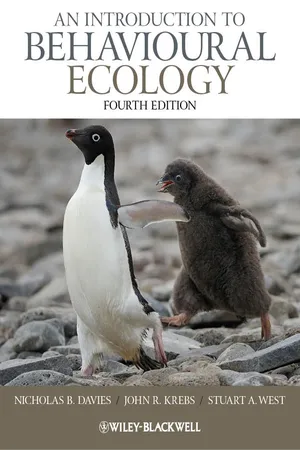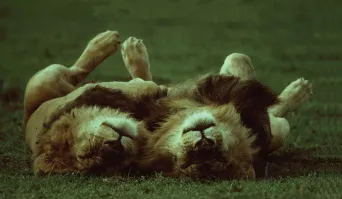![]()
CHAPTER 1
Natural Selection, Ecology and Behaviour
Watching and wondering
Imagine you are watching a bird searching in the grass for food (Fig. 1.1). At first your curiosity may be satisfied simply by knowing what species it is, in this case a starling Sturnus vulgaris. You then watch more closely; the starling walks along and pauses every now and then to probe into the ground. Sometimes it finds a prey item, such as a beetle larva, and eventually, when it has collected several prey items, it flies back to the nest to feed its hungry brood.
For students of behavioural ecology, a whole host of questions comes to mind as this behaviour is observed. The first set of questions concerns how the bird feeds. Why has it chosen this particular place to forage? Why is it alone rather than in a flock? Does it collect every item of food it encounters or is it selective for prey type or size? What influences its decision to stop collecting and fly back to feed its chicks?
Another set of questions emerges when we follow the starling back to its nest. Why has it chosen this site? Why this number of chicks in the nest? How do the two adults decide on how much food each should bring? Are these two adults the mother and father of all the chicks? Why are the chicks begging so noisily and jostling to be fed? Surely this would attract predators to the nest. If we could follow our starlings over a longer period, we may then begin to ask about what determines how much effort the adults put into reproduction versus their own maintenance, about the factors influencing the timing of their seasonal activities, their choice of mate, the dispersal of their offspring and so on.
Behavioural ecology provides a framework for answering these kinds of questions. In this chapter we will show how it combines thinking about behaviour, ecology (the ‘stage’ on which individuals play their behavioural strategies) and evolution (how behaviour evolves by natural selection). But first, we need to be clear about exactly what we mean when we ask the question ‘why?’
Tinbergen’s four ‘why’ questions
Niko Tinbergen (1963), one of the founders of scientific studies of animal behaviour in the wild, emphasized that there are four different ways of answering ‘why’ questions about behaviour. For example, if we asked why male starlings sing in the spring, we could answer as follows:
(1) In terms of causation. Starlings sing because the increasing length of day triggers changes in their hormones, or because of the way air flows through the vocal apparatus and sets up membrane vibrations. These are answers about the mechanisms that cause starlings to sing, including sensory and nervous systems, hormonal mechanisms and skeletal–muscular control.
(2) In terms of development or ontogeny. For example, starlings sing because they have learned the songs from their parents and neighbours, and have a genetic disposition to learn the song of their own species. This answer is concerned with genetic and developmental mechanisms.
(3) In terms of adaptive advantage or function. Starlings sing to attract mates for breeding, and so singing increases the reproductive success of males.
(4) In terms of evolutionary history or phylogeny. This answer would be about how song had evolved in starlings from their avian ancestors. The most primitive living birds make very simple sounds, so it is reasonable to assume that the complex songs of starlings and other song birds have evolved from simpler ancestral calls.
Causal and developmental factors are referred to as proximate because they explain how a given individual comes to behave in a particular way during its lifetime. Factors influencing adaptive advantage and evolution are called ultimate because they explain why and how the individual has evolved the behaviour. To make the distinction clearer, an example is discussed in detail.
Proximate versus ultimate explanations
Reproductive behaviour in lions
In the Serengeti National Park, Tanzania, lions (Panthera leo) live in prides consisting of between three and twelve adult females, from one to six adult males and several cubs (Fig. 1.2a). The group defends a territory in which it hunts for prey, especially gazelle and zebra. Within a pride all the females are related; they are sisters, mothers and daughters, cousins and so on. All were born and reared in the pride and all stay there to breed. Females reproduce from the age of four to eighteen years and so enjoy a long reproductive life.
For the males, life is very different. When they are three years old, young related males (sometimes brothers) leave their natal pride. After a couple of years as nomads they attempt to take over another pride from old and weak males. After a successful takeover they stay in the pride for two to three years before they, in turn, are driven out by new males. A male’s reproductive life is therefore short.
The lion pride thus consists of a permanent group of closely related females and a smaller group of separately interrelated males present for a shorter time. Brian Bertram (1975) considered two interesting observations about reproductive behaviour in a pride.
(1) Lions may breed throughout the year but, although different prides may breed at different times, within a pride all the females tend to come into oestrus at about the same time. The mechanism, or causal explanation, is likely to be the influence of pheromones on oestrus cycles (Stern & McClintock, 1998). But why are lionesses designed to respond in this way? One adaptive advantage of oestrus synchrony is that different litters in the pride are born at the same time and cubs born synchronously survive better. This is because there is communal suckling and, with all the females lactating together, a cub may suckle from another female if its mother is out hunting. In addition, with synchronous births there is a greater chance that a young male will have a similar-aged companion when it reaches the age at which it leaves the pride. With a companion a male is more likely to achieve a successful take-over of another pride (Bygott et al. 1979; Packer et al. 1991).
Female lions show synchronous oestrus
(2) When a new male, or group of males, takes over a pride they sometimes kill the cubs already present (Fig. 1.2b). The causal explanation is not known but it may be the unfamiliar odour of the cubs that induces the male to attack them. But, whatever the mechanism, why are male lions designed to respond in this way?
Males kill cubs after take-over
The benefit of infanticide for the male that takes over the pride is that killing the cubs fathered by a previous male brings the female into reproductive condition again much more quickly. This hastens the day that he can father his own offspring. If the cubs were left intact then the female would not come into oestrus again for 25 months. By killing the cubs the male makes her ready for mating after only nine months. Remember that a male’s reproductive life in the pride is short, so any individual that practises infanticide when he takes over a pride will father more of his own offspring and, therefore, the tendency to commit infanticide will spread by natural selection.
The take-over of a pride by a new coalition of adult males also contributes to the reproductive synchrony of the females; because all the dependent offspring are either killed or evicted during the take-over, the females will all tend to come into oestrus again at about the same time (Packer & Pusey, 1983b). Interestingly, the sexual activity of the females is most intense during the first few months after a take-over. The females play an active role in soliciting copulations from several males and this appears to elicit competition between different male coalitions for the control of the pride, with the result that larger coalitions eventually become resident. This is of adaptive advantage to the female because she needs protection from male harassment of her cubs for over two years in order to rear her cubs successfully (3.5 months gestation plus 1.5–2 years with dependent young) and only large male coalitions are likely to remain in the pride for more than two years. High sexual activity in females at around the time of take-overs may therefore incite male–male competition and so result in the best protectors taking over the pride (Packer and Pusey, 1983a).
Table 1.1 Summary of causal and functional explanations for two aspects of reproductive behaviour in lions (Bertram, 1975; Packer and Pusey, 1983a, 1983b).
|
| 1 Females are synchronous in oestrus | Chemical cues?
Take-overs by males | Better cub survival
Young males survive better and have greater reproductive success when they leave pride if in a group |
| 2 Young die when new males take over pride | AbortionTake-over males kill or evict young | Females come into oestrus more quickly
Male removes older cubs which would compete with his young |
The differences between the causal and functional explanations of these two aspects of reproductive behaviour in the lions are summarized in Table 1.1. The key point is that causal explanations are concerned with mechanisms, while functional explanations are concerned with why these particular mechanisms (rather than others) have been favoured by natural selection.
Causal and functional explanations of lion behaviour
Natural selection
The aim of behavioural ecology is to try and understand how an animal’s behaviour is adapted to the environment in which it lives. When we discuss adaptations we are referring to changes brought about during evolution by the process of natural selection. For Charles Darwin, adaptation was an obvious fact. It was obvious to him that eyes were well designed for vision, legs for running, wings for flying and so on. What he attempted to explain was how adaptation could have arisen without a creator or, put another way, how you could get the appearance of design without a designer. His theory of natural selection, published in the Origin of Species (Darwin, 1859), can be summarized as follows:
(1) Individuals within a species differ in their morphology, physiology and behaviour (variation).
(2) Some of this variatio...



